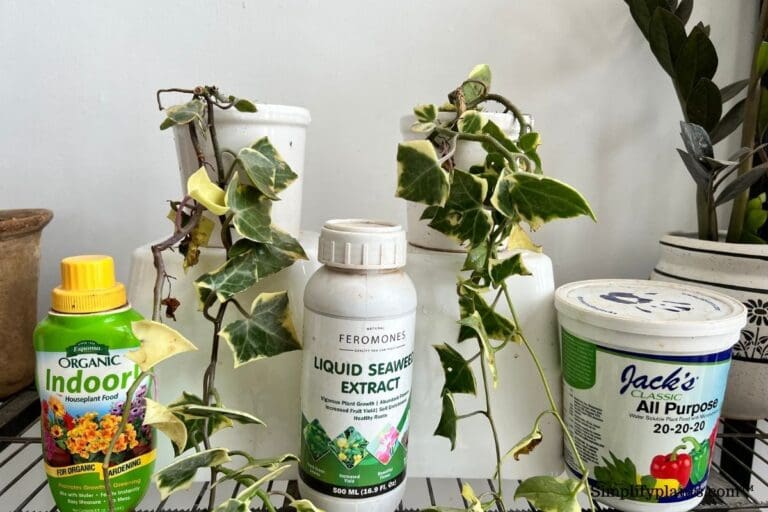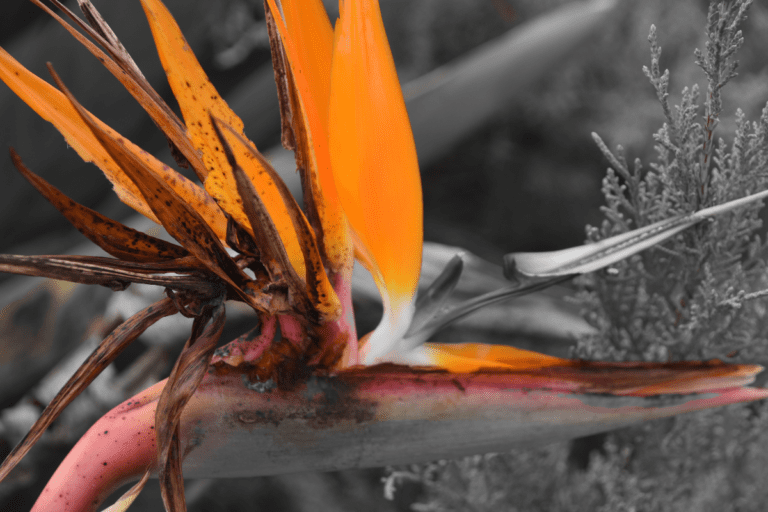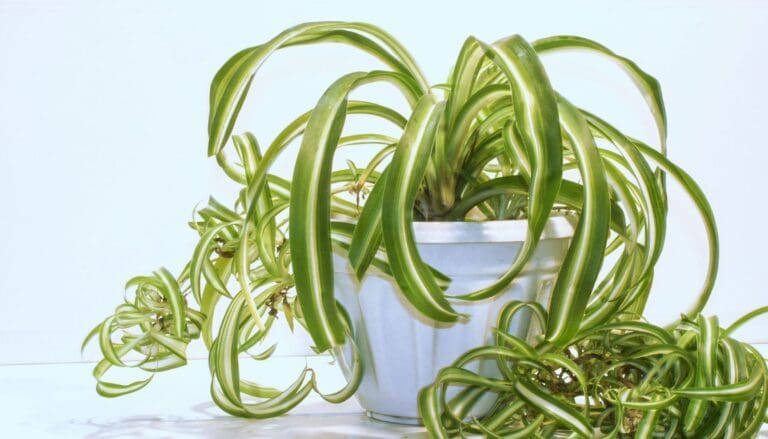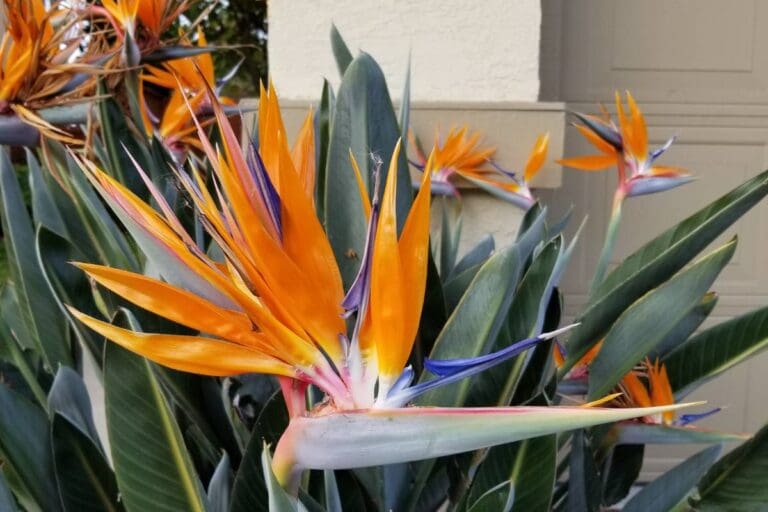9 Reasons Why Your Umbrella Plant Has White Spots
The umbrella plant or Schefflera belongs to the tropical regions and is widely grown as an indoor plant due to its hassle-free nature and glossy umbrella-shaped foliage. However, one distinctive problem that worries these plant owners is the appearance of white spots on their leaves.
Pest infestations, sunburn, and poor lighting conditions are common reasons behind white spots on your Schefflera leaves. You must apply neem oil to eradicate the pests and place the plant in a spot where it gets bright indirect light. Also, keep the plant away from direct light.
In this article, I will explain all the reasons behind white spots on Schefflera and suggest remedies to fix them and prevention tips to keep your umbrella plant healthy.

Please note: Simplify Plants is reader-supported. Some links in the post are affiliate links and I get a commission from purchases made through links in the post.
Why are my umbrella plant leaves turning white?
The green color of the leaves comes from chlorophyll that the plant produces with the help of sunlight, water, and food.
White spots on the plant’s leaves are a sign that the plant cannot create enough chlorophyll due to some internal or external problem stressing the plant.
Different reasons lead to the appearance of white spots on the leaves, and by closely analyzing the symptoms, we can find out the problem and thereby take necessary actions to cure and prevent the issue in the future.
Let us now find out the reasons that lead to white spots on your Schefflera plant.
Sunburn
The intensity and duration of sunlight that your Schefflera receives affect them.
In nature, Schefflera grows under shades of bigger trees.
Hence they cannot withstand direct scorching sunlight and need indirect or dappled sunlight to grow.
Exposing this plant to harsh strong sunlight can lead to sunburn.
If your plant gets sunburnt, there will be brown and yellow spots on the leaves that become white over time.
Sunburn happens more during the peak summer months when the sunlight is most intense.
Once the leaves get scorched, there is no way to make them green again.
However, you can prevent newer leaves from getting burnt.

Solution:
This problem can be fixed easily by shifting the plant to another spot. All you need to do is protect your plant from direct sun rays.
In winters, you can give 1-2 hours of mild sunlight, but in summers, it is important to shield them.
If your plant is kept near a window, bring it 5-6 feet away from it or hang a sheer curtain to shield the plant.
If your plant is outside, shift it to a spot under a bigger tree or an s wall where direct sunlight will not reach.
Also read: Can Schefflera Get Too Much Sun? (Sunburn)
Low light
Sunlight and water are the two most essential elements required by plants to make food.
If your Schefflera does not get enough sunlight that it requires to grow, it suffers from Chlorosis.
It is a condition when plants cannot make enough chlorophyll due to extremely low light, making the leaves lose their green pigment and turn pale green and white.
Along with that, the plant becomes leggy and has stunted growth.
Solution:
If your Schefflera suffers from low light, you must give the plant more light.
For that, shift the plant where it gets bright indirect light during the day.
Keep it a few feet away from a sunlit window or balcony.
If you do not get adequate sunlight, install artificial lights, which will give the plants the necessary light.
Also read: What Kind Of Light Does A Schefflera Need?
Lack of nutrients

Houseplants need added nutrients because, with every watering, the nutrients in the soil start depleting.
Plants that are grown outdoors get the nutrients directly from the soil.
However, those that grow in containers do not have that access.
Thus, they have to be fed with fertilizers periodically.
For the healthy growth of the plant, they need micronutrients like magnesium, iron, calcium, copper, etc., and macronutrients like phosphorous, nitrogen, and potassium.
Iron deficiency in Schefflera makes the area between the veins of new leaves turn pale white.
Manganese deficiency turns the leaves into a pale green.
If left untreated, the deficiency progresses, and the leaves develop white spots.
Solution:
Fertilizing your Schefflera in the growing season is very important.
You must use compost or a balanced NPK 20:20:20 to feed the plant and give it essential nutrients.
However, you must remember Schefflera is not a heavy feeder, so fertilizing it too frequently can damage the plant.
Also, do not fertilize during the fall and winter seasons.
Water the plant 1-2 days before fertilizing as fertilizing in dry soil can burn the plant.
Also read: How Often Should I Fertilize My Schefflera? (+Ideal NPK Ratio)
Fluctuations in temperature
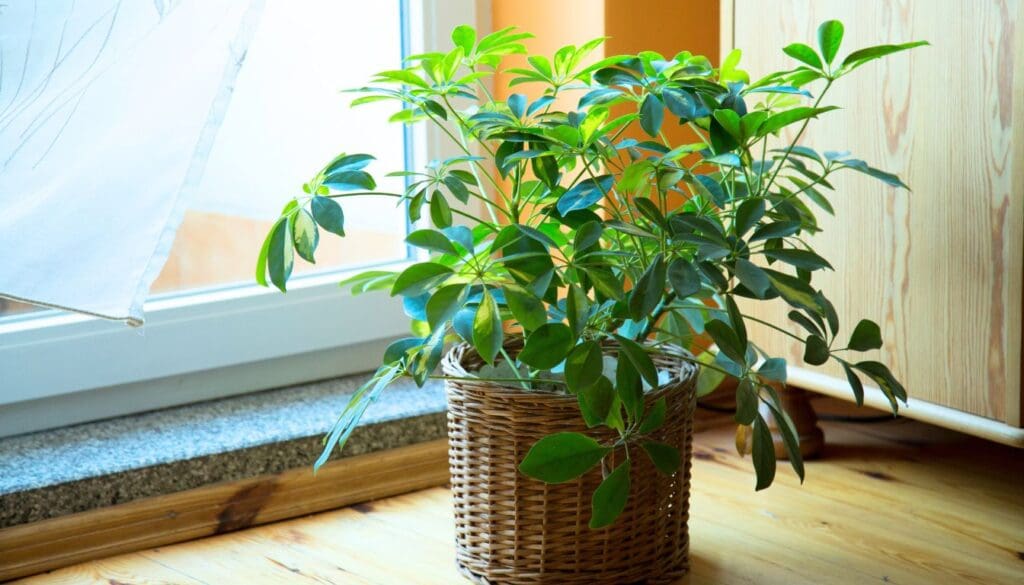
Schefflera are plants that grow in a warm tropical climate.
They prefer moderate temperatures between 65-90°F and cannot tolerate extreme temperature differences.
If you keep the plant at a spot where there are vast fluctuations in temperature, the effect will be visible to them.
The leaves tend to droop, get pale and get into stress.
Solution:
- Do not keep the Schefflera near doors or windows opened and closed frequently.
- Keep the plant away from drafts and vets.
- Keep this plant away from fireplaces, air conditioners, or heaters. If you want to keep the plant in the same room as these sources, ensure a few feet of distance between them.
- Do not keep the plant near a frosted window or hot window panes where the leaves might get rubbed against the panes.
Also read: Schefflera Plant Temperature Tolerance: Ideal Temperature+Problems
Poor water quality
The quality and temperature of the water have an impact on the plant.
Tap water contains minerals, fluorine, bicarbonates, and chlorine, which are unsuitable for this plant.
If you water the plant with this water, all the minerals start accumulating on the surface of the leaves, creating a layer of salt deposits leading to white spots on them.
Also, if you water the plant with too cold water, it stresses them and leads to discoloration.
The extremely cold water shocks the plant, damaging the chloroplasts and leading to white spots on the leaves.

Solution:
- Instead of using tap water, use rainwater or distilled water on the plants.
- If you do not have that source, use the tap water but let it rest overnight so that the minerals reduce, and you can use the water at the top to water the plant.
- Always use water at room temperature for your plant.
Also read: How Much Water Does A Schefflera Plant Need? (Watering Guide)
Edema
When you keep your Schefflera underwatered and bone dry for a long time and give it too much water right after that, it causes shock to the plant, called edema.
This makes white spots on the leaves.
Solution:
Always water when the soil is dry.
Avoid both underwatering and overwatering as both are harmful.
Use a moisture meter to check the moisture content of the soil to know when to water.
Make sure to use well-draining soil and pot with a good drainage system.
Alkaline soil
Schefflera plants prefer slightly acidic sandy, loamy soil with a pH of 6.0 to 6.5.
However, if the soil tends to lose acidity and become alkaline, the plant shows white spots on its leaves.
If the soil becomes alkaline, the Schefflera has difficulty absorbing the nutrients from the soil.
Solution:
If the soil becomes alkaline, you must make it acidic.
Adding organic elements like compost, manure, leaf mold, and pine bark can reduce the pH of the soil and turn it more acidic.
Adding coffee grounds to the compost also helps to make the soil acidic.
Fungal disease
Certain fungi can cause discoloration and white spots on the leaves of your umbrella plant.
Powdery mildew
These are one of the most common fungi that attack plants and are quite easy to identify.
It looks like a layer of thin talcum powder spread on the leaves.
This fungus affects the plant’s lower parts first and gradually goes upwards.
Initially, they start in small areas, and as they spread, the spots increase too, and if not treated, they cover the whole plant making it droopy and weak, gradually killing it.
One primary reason for the growth of mildew attacks is the extremely high humidity around the plant.
The fungus flourishes in warm, humid areas with low light and airflow, mostly when plants are kept in groups without sufficient ventilation.
Solution:
It is important to take steps in the initial stages.
Since the external conditions of the plant cause this fungus, it is important to make necessary changes:
- Shift the position of the Schefflera. Keep it in a place where it gets more air circulation and light.
- Make sure the leaves of the plants are dry. Misting should always be done in the morning, so it gets time to dry and evaporate throughout the day. Wet leaves attract fungus to feed on them.
- Water the soil when you see the topsoil dry. If you are unsure, test the soil’s moisture content with a moisture meter or finger.
- If you notice the fungus in the initial stages, prune off the infected parts.
- Give the plant a good wash, and let it dry by keeping it in bright indirect light.
- Then spray the plant with a fungicide.
Leaf spot disease
Another disease is the leaf spot disease, widely seen in Schefflera plants that leave white and yellow spots on the leaves is the leaf spot disease.
It spreads quickly and is mainly caused by overwatering and dampness.
Solution:
- Remove the infected parts of the plant.
- Improve ventilation around the plant.
- Watch the watering routine. Water the plant only when the soil is dry.
- After misting, let the plant dry in the air and light.
Root rot

Root rot happens due to overwatering when the roots stay soaked in water for too long.
This causes the leaves to turn yellow or white and limp.
If you suspect root rot, you must check the roots without delay as this is dangerous for plants and can kill the plant easily.
Solution:
- Take the plant out of the pot.
- Wash the roots and examine them.
- Trim the infected rotten roots.
- Prepare a fresh, light well-draining soil mix.
- Repot the plant in fresh soil and a new pot.
- Do not overwater the plant and water only when the soil is dry.
Also read: Root Rot In Schefflera: Signs, Causes & How To Fix
Pest infestations
Pest attacks are very harmful to the plants and, if left untreated, can kill them.
They generally attack due to incorrect care routines and can be removed with the right actions, which I will discuss below.
Mealybugs: These are one of the nastiest bugs that attack the plants and stick themselves to the body, sucking out all the nutrients from the plant, making it weak, and killing it.
They are tiny white bugs that mostly stay hidden on the underside of the leaves.
After feeding, they leave a sticky substance on the leaves called honeydew which attracts ants to the plant.
Aphids: These tiny bugs feed on the plant’s sap and leave white spots on the leaves, slowly killing the plant.
Thrips: These come in white, yellow, brown, or black colors and feed on the plant, making it weak, discolored, and twisted.
They leave silvery white dots n the leaves, which further cause more pests and fungus to the plant.
Spider mites: Spider mites are tiny and are hard to notice in the initial stages.
If you notice and find spider webs around the plant, it is a sign that spider mites have attacked the plant.
Spider mites mainly attack plant that is left bone dry, and there is no humidity around them spider mites invades.
They pierce the leaves of the Schefflera and feed on them.

How to remove pests from my Schefflera?
Now that we know about the various pests that attack the plant and create white spots on the leaves let’s understand how to remove these bugs and keep your Schefflera pest free.
- The first step to clearing the pest from your plant is to wear gloves to protect your skin.
- Next, try to handpick the visible pests.
- Prune off the parts that are heavily infested.
- Take the Schefflera under a shower and give the plant a good wash focusing on the infested areas.
- Once done, keep your plant at a spot that receives good indirect light and airflow.
- Next, dip a cotton ball in rubbing alcohol over the areas that still have pests.
- After that, spray Neem oil and water and spray it generously all over the plant. This is organic and does not harm your plant but removes all pests effectively. Repeat it 2-3 times per week until you see the pest infestation clearing.
- If you do not have Neem oil, make a solution with water, hand wash soap, and spray it all over the plant. Leave it for a few hours, and then wash it off. Repeat this for few times until the pests are cleared.
- If these methods do not work, use a pesticide. However, be careful with them as too much can harm the plants. Read the instructions carefully before using them.
Also read: Schefflera Pest Problems: Common Pests & Diseases+How To Fix
How do I prevent white spots on my Umbrella plant?

Now that we have discussed the various causes and remedies of white spots let us discuss some tips to keep the plant healthy.
| Factor | Care Tips |
|---|---|
| Placement | Choose a spot for your Schefflera, which has good air circulation. Keeping plants in small corners or grouped reduces air flow around them, suffocating and creating an unsuitable environment for this plant. |
| Watering | The right watering schedule is important. You must understand how much water and how frequently you should water the plant. If you do not understand, invest in a moisture meter to help you understand the plant’s watering needs. Avoid using tap water and cold water. |
| Humidity | Use a humidifier or pebble tray to maintain humidity around the plant. |
| Light | Sunlight is essential for the plant to photosynthesis. Keep the plant at a spot that receives dappled or indirect sunlight. Remember, this plant cannot tolerate harsh sunlight or low light. In winter, give the plant mild sunlight to keep it warm and shield it from direct harsh sunlight in summers. |
| Fertilizer | Fertilize your umbrella plant periodically during the growing season around March and September with an NPK 20:20:20 or compost. |
| Pest and fungus | Whenever you notice any pest or fungus growth on any parts of the plant, you must prune them off at the earliest to prevent it from spreading. Spray the plant with Neem oil periodically to repel all pests and keep the leaves clean. |
| Repotting | Whenever you find the plant getting root bound, repot it to a pot 2 inches bigger than the existing pot. Every few years, with fresh soil mix, repotting keeps the plant healthy and happy. |
| Winter | Protect the Schefflera from frost. |
Final words
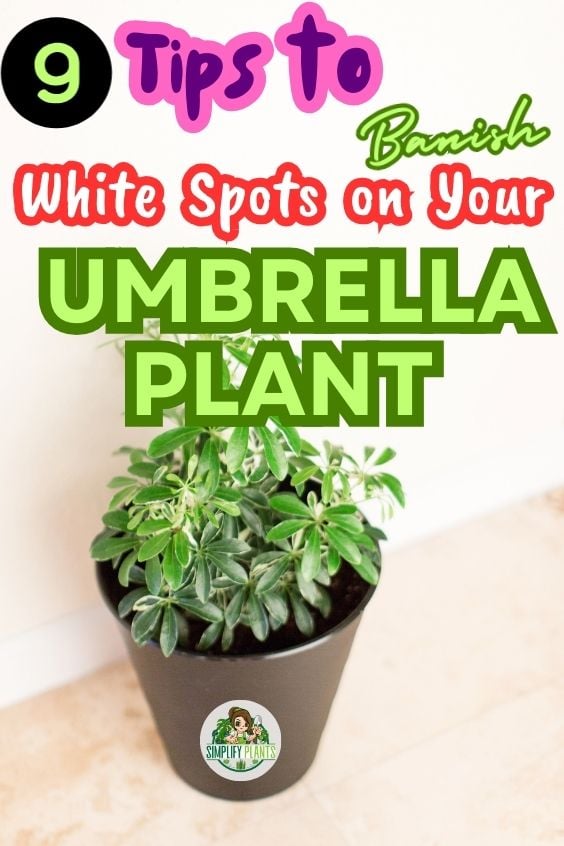
Schefflera plants do not need a lot of maintenance, but if you want your plant to thrive, you must understand the correct conditions it needs.
By following the above tips, you can keep your plant happy and healthy and prevent the emergence of white spots on its leaves.
Reference: Wikipedia, Sciencedirect, Britannica, American Society for Horticultural Science, Schefflera taxonomic history.
Recommended Garden Supplies
| Product Image | Our Recommended Gardening Supplies | Check Offers! |
|---|---|---|
Top Top
Top
Top
Top
Top
Top
Top
Top | rePotme Houseplant and Tropical Classic Potting Soil Mix | Check Offer On Amazon |
 Top
Top
Top
Top
Top
Top
Top
Top | Espoma Organic Indoor Plant Food | Check Offer On Amazon |
 Top
Top
Top
Top
Top
Top
Top
Top | GooingTop LED Grow Light 6000K Full Spectrum Clip Plant Growing Lamp | Check Offer On Amazon |
 Top
Top
Top
Top
Top
Top
Top
Top | Soil Moisture Meter | Check Offer On Amazon |
 Top
Top
Top
Top
Top
Top
Top
Top | Govee Hygrometer Thermometer, Bluetooth Enabled! | Check Offer On Amazon |
 Top
Top | LEVOIT Humidifiers for Large Room(Best For Plants) | Check Offer On Amazon |
 Top
Top
Top
Top
Top
Top
Top
Top | Upgraded DIY Automatic Drip Irrigation Kit, 15 Potted Houseplants Support | Check Offer On Amazon |
 Top
Top
Top
Top
Top
Top
Top
Top | Stainless Steel Heavy Duty Gardening Tool Set | Check Offer On Amazon |
 Top
Top
Top
Top
Top
Top
Top
Top | Bonide Insecticidal Soap | Check Offer On Amazon |
 Top
Top
Top
Top
Top
Top
Top
Top | Bonide 32 oz Spray Neem Oil for Organic Gardening | Check Offer On Amazon |
 Top
Top
Top
Top
Top
Top
Top
Top | Garden Safe Fungicide | Check Offer On Amazon |

